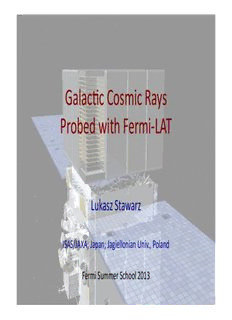
Galactic Cosmic Rays Probed with Fermi-LAT PDF
Preview Galactic Cosmic Rays Probed with Fermi-LAT
Galac%c Cosmic Rays Probed with Fermi-‐LAT Lukasz Stawarz ISAS/JAXA, Japan; Jagiellonian Univ., Poland Fermi Summer School 2013 Outline • Solar Flares • Gamma-‐Ray Binaries • Supernova Remnants • Galac%c ISM Solar Flares Ackermann et al. 2012, ApJ 745: M2-‐class flare SOL2010-‐06-‐12T00:57. The flare produced an ~50s impulsive hadronic fit burst of hard X-‐ and gamma-‐ray emission (pion-‐decay) up to at least 400 MeV observed by the Fermi GBM and LAT. The accelera%on of hundreds of keV electrons and hundreds of MeV electrons and/or protons in the chromosphere took place with 10s lag. leptonic fit (brems.) High-‐Energy Astrophysics • accelera%on of protons and electrons; • “leptonic/hadronic” modeling degeneracy; • hadronic emission accompanied by the produc%on of neutrinos and secondary electrons; • hadronic emission: inelas/c proton-‐proton interac/ons • hadronic emission: photo-‐mezon produc/on High-‐Energy Astrophysics • ultrarela%vis%c electrons are very efficient emibers! • leptonic emission: bremsstrahlung • leptonic emission: synchrotron • leptonic emission: inverse-‐Compton γ-‐ray γ-‐ray γ-‐ray Gamma-‐Ray Binaries Abdo et al. 2011, ApJL 736: LAT detec%on of the binary system PSR B1259−63 (radio pulsar!) around periastron. Gamma-‐Ray Binaries Abdo et al. 2009, ApJ 706: Detec%on of the orbital modula%on in the gamma-‐ray lightcurve and spectrum of high-‐mass X-‐ray binary LS 5039 (neutron star candidate); exponen%al cutoff around 2 GeV; the phase difference can be explained mostly as a result of the compe%%on between IC scabering on high-‐energy electrons and TeV pair produc%on. Gamma-‐Ray Binaries Abdo et al. 2009, Science 326: a variable source coinciding with the posi%on of the high-‐mass x-‐ray binary system Cygnus X-‐3 (black hole candidate); iden%fica%on secured by the detec%on of the orbital period in gamma rays, and a correla%on of the LAT flux with radio emission from the rela%vis%c jets. Gamma-‐Ray Binaries Abdo et al. 2010, Science 329: Symbio%c binary V407 Cyg -‐ small white dwarf and large red giant orbi%ng each other closely. Nova thermonuclear runaway on WD surface. Nova shell ini%ally freely expands into asymmetric dense medium. Shell toward RG slows down quickly. Hence gamma rays peak early when efficiency for pion and inverse-‐Compton processes is favorable. Shell decelerates slowly away from RG. Hence X rays peak later, flux increasing with volume of shock-‐heated gas. Gamma-‐Ray Binaries Ackermann et al. 2012, Science 335: intensity and spectral modula%on of 1FGL J1018.6–5856 discovered with Fermi-‐LAT implies a binary nature of the system (similar to LS 5039).
Description: